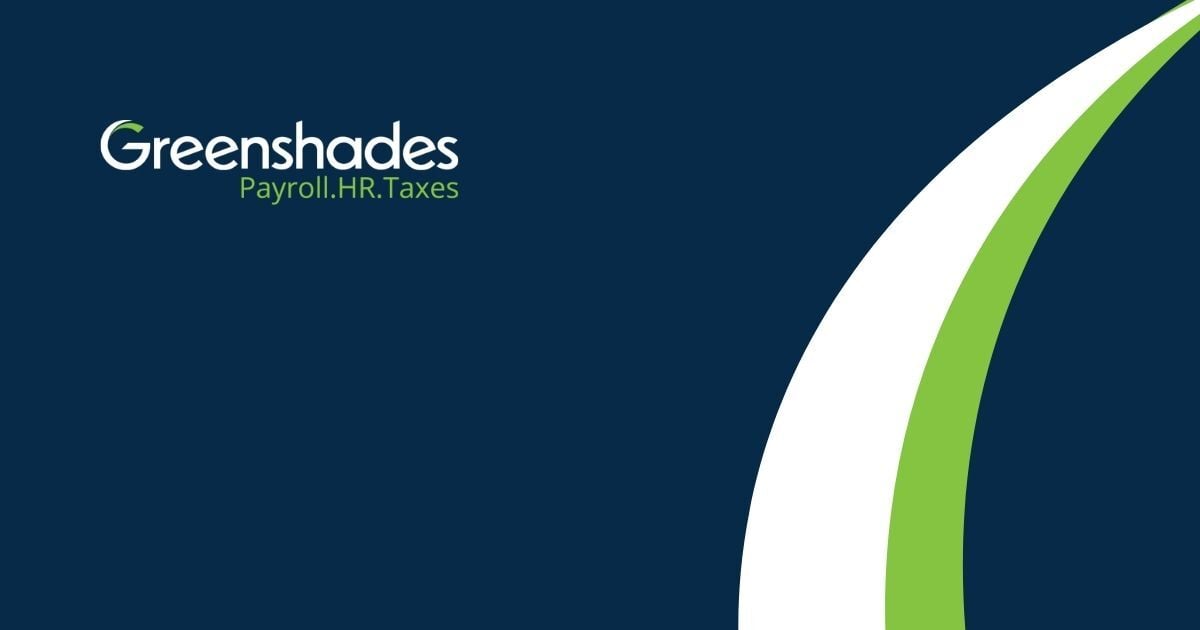Empower HR to Create a Better Employee Experience

HR Solutions Simplified
First Day Made Easy
Make onboarding new employees easier than ever by giving them the ability to confirm and complete important documents such as W-4s, and sign up for benefits.
Empower Employees
Provide one location for employees to change personal information, access important documents, view timesheets, submit expenses, request time off, view pay history, and more.
Manage New Talent
Recruiting has never been easier, using Greenshades simple tracking and report tools you can focus on finding and retaining talent
Employee Self-Service
Make it easy for employees to access the resources they need to thrive with one dashboard that centralizes manager communications, performance reviews, organizational structures, expenses, and other key HR documents.
- Everything in One Place
- True Self-Service
- 360 View for Managers
Employee Onboarding
Our onboarding flows help you welcome new employees to your team, making the process compliant and delightful.
- Employees can Confirm their Information
- Multi-Position and Locations Support
- Customizable Workflows
Certifications and License Management
Keep track of all your industry-specific requirements, certifications, and licensing, including vaccination tracking.
- Manage Vaccine Compliance
- Maintain Compliance Year Round
- Automate with Ease
Documents and Organization Charts
Take a break from the paperwork! Move forms, employee handbooks, directories, and virtually any other business document to the cloud.
- Go Paperless
- Centralized Documentation
- Organizational Insight
Learning Management
The Greenshades employee portal provides access to LearnUpon, a learning management system that optimizes the entire training process.
- Course Creation
- Training from Anywhere
- Learner Engagement
Applicant Tracking and Recruiting
Streamline your recruiting process with simple tracking and reporting tools, so you can focus on your greatest strength - finding the best talent for your team.
- Streamline from Applicant to Employee
- Candidate Tracking and Overview
- Customize Reports
COMPLIANCE WITHOUT COMPROMISE
The Greenshades Commitment
With Greenshades your payroll taxes will meet the highest standards of compliance.
Our Customers Say It Best
"Over the past five years, we've expanded our use of Greenshades to include their full suite of solutions, significantly streamlining our payroll and HR processes, reducing manual paperwork, and making the platform accessible even for our non-tech-savvy staff. Greenshades' ongoing support and user-friendly design have been instrumental in enhancing our operational efficiency and overall productivity."
Gia Mathos Lamm
CFO, Agape of AppletonFREQUENTLY ASKED QUESTIONS
Discover the most commonly asked questions about HR software.
What is HR software?
HR software is a technology-driven platform for managing your workforce, including learning and development objectives, core company policy and guidelines control, core employee and demographic information, and much more.
What does HR software do?
HR software removes the need for managing employee records on paper. Managing this digitally allows organizations to build and enforce standards across the organization, while also easily searching and identifying pertinent information. Records are automatically retained, and a business continuity plan is more easily managed.
What are the benefits to using HR software?
The use of HR software can help save time for your HR managers by allowing information to flow freely throughout the HR software, streamlining your HR operations. Using HR software provides many benefits for not only your HR staff but also for your employees. Providing employees with functions such as their own self-service portal can help your employees feel stronger ties to the organization.
For the Employer
- Centralize HR functions in the cloud
- Onboarding software makes the first day easy
- Increase productivity by streamlining HR functions
- Increased employee engagement
- Employee development using performance management software
- Maintain complex HR compliance regulations
- Monitor time-off requests from any location
For the Employee
- Access to pay history, important HR documents from their own portal
- Ability to update personal information
- Notifications and alerts to employees for important updates
- Performance management to help career growth
- Easily request and manage time-off request
What features should I look for in an HR software?
The features you should look for in HR software depend solely on your business needs. Below is a list of key features that can greatly improve efficiency in the HR departments, some may not be applicable to your business, but they are worth considering streamlining your HR task:
- Applicant tracking and recruiting
- Employee Onboarding
- Employee self-service
- Documentation and reporting
- Performance management
- Learning management
- Reporting capabilities
- Features to maintain compliance
Is implementing HR software easy?
Implementing HR software can be an easy process. The process starts by understanding your business needs, evaluating HR providers, and then the process of implementation.
Understand your business needs
Evaluate your HR department to understand the areas needed for improvement. You want to be sure the HR software you implement has the features and functions you need to handle your business needs. You will also want to evaluate your budget, utilizing HR software can be a cost-effective solution for any size business.
Evaluate HR software providers
There is a wide array of HR providers to choose from for your HR software that offers similar product offerings, however, there are key differences for each provider. Key differences to keep in mind can include:
- Understanding what key industries, the provider has success in.
- What sized organization does the provider has success serving. If you are a large organization, a provider that primarily services smaller organizations may not have the capabilities to handle your HR needs.
- Providers may have expertise in servicing certain geographic locations. You may choose to keep your provider local to your business, or maybe in the same time zone to be aligned with your provider’s business hours.
- Compare packages and pricing, every provider structures their packages and pricing differently. You understand the features and functions needed for your HR department, explore your options to see what package is the most cost-effective to solve your business needs.
- Be sure the software you choose can integrate with any existing products you already have, or you are looking to use for your business. Work with your IT team to ensure the software you choose is compatible with your business.
Implementing HR software
Implementing HR software can take anywhere from a few weeks to a few months, depending on the size and scope of the implementation.
Here are some best practices to consider when approaching an HR software implementation.
- Plan, plan, plan, and then plan some more. You can never do too much planning when thinking through an implementation. Having a clear understanding of the goals of a project up front is especially important. At the beginning of the project, it is important to have some type of formal kickoff where these goals can be communicated across the implementing parties and stakeholders. Beyond goals, setting up some key milestones and benchmarks along the way will help evaluate if the project is on track or needs adjustments.
- Communication. Communicating across your entire organization, not just those directly implementing the new software, is critical. This allows your team to get feedback early on to ensure you understand the perspective of all impacted parties. Additionally, it’s a great way to get buy in from other departments, which you made need to leverage later in the implementation.
- Take a phased approach, when possible. HR software offerings can be quite robust in nature. Depending on the platform you are implementing, while it may technically be possible to implement everything at once, that may just be a recipe for additional stress. If possible, consider splitting the implementation into multiple phases. For example, start by implementing the core employee HR records and basic employee self-service, and save Benefits and Learning Management for phase 2. Depending on the size of your organization, you may even want to limit this rollout to just a specific department or location, so you have a chance to receive feedback and better learn the system. As you roll the system out to a larger audience, these phase 1 employee groups can be your internal champions and even SMEs within the application.
- And finally, be an advocate for your company and help them prepare for this change. Communicate early and often on changes that are coming. Proactively work to share as much information as possible and make yourself / your team available to answer questions. Consider hosting an “Ask us Anything” type session (can be recorded and re-shared on demand), as well as providing FAQs and other documents for the company to leverage. As you are rolling the system out to the entire company, this is a great time to bring in employees and department heads who were early adopters / users during the phased rollout. They can act as unbiased advocates and should help provide a motivational boost to your rollout efforts.
What is the difference between hris and hrms?
There are typically 3 terms that you will hear interchangeably when researching HR software. Each term represents HR software, just at different times of technological advancement;
- Human Resource Information System (HRIS) is a form of HR software that has a heavy focus on housing employee data, eliminating the need for paper and spreadsheets. Keeping track of important personal information, documents, and forms is essential for any HR department.
- Human Resource Management System (HRMS) is typically an on-premises technology that goes one step further from HRIS since it not only houses the employee information but engages with the employee throughout their employment using tools such as performance management and more robust functions.
- Human Capital Management (HCM) is the most advanced form of HR software. With the growth of technology in the HR department, HCM represents a cloud-based comprehensive suite of HR tools. HCM goes beyond employee engagement to strategic planning and payroll.
With such a quick advancement in could-based technology, it is easy to use the terms HRIS, HRMS, and HCM interchangeably. It is important to understand they all do have the same goal to streamline the HR process.


































